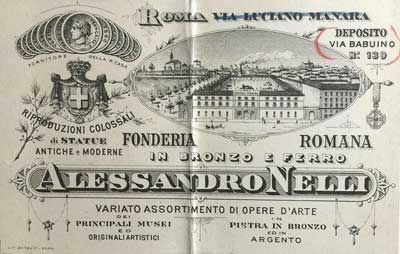To interactively explore this work, tap or click on on the artist’s name, the title, and on features in the work itself.
Bronze, 50.5 x 33 in., McMullen Museum of Art, Boston College, 1988.165
Tap or click on points of interest in the image to learn more ➡

Figure

The Prima Porta’s stature and proportions were influenced heavily by classical Greek sculpture, the pinnacle of artistry to Roman sculptors. Polykleitos created his Doryphoros (“spear-bearer”) in bronze circa 440 BCE. The Doryphoros pictured here was found in the ruins of Herculaneum (destroyed along with Pompeii in 79 CE), and like the Prima Porta, is one of numerous marble copies of a bronze original. The Doryphoros's contrapposto stance achieves a lifelike dynamism of the human form; facial features, locks of hair, head shape, raised and lowered arms—all of these distinctive characteristics are in the Prima Porta. While the McMullen Augustus holds a staff in his right hand with the left in forward in an adlocutio (addressing) pose, it is thought that like the Doryphoros, the Prima Porta may have held a spear in the left hand and possibly a laurel branch, symbolic of victory, in the right.
Breastplate

Augustus’s breastplate is the Prima Porta’s centerpiece and is open to interpretation, making the sculpture a subject of continual study and reevaluation. Divine and mortal, past and present are combined to depict Augustus’s reclamation of legionary standards that were captured by Parthians from Crassus in 53 BCE and in the 40s BCE from Mark Antony. The center shows a “barbarian” Parthian (identifiable by his baggy pants) who is returning a standard to a Roman soldier. This figure is sometimes interpreted as Tiberius, Augustus’s heir who had a role in retrieving the standards in 20 BCE.
It is a scene of peace; sky god Caelus above, earth goddess Tellus with cornucopia and two infants below. Apollo with his lyre on the bottom left and Diana with her stag on the bottom right are mirrored by sun god Sol with his chariot (top left) and moon and dawn goddesses Luna and Aurora (top right). Sphinxes, symbolic of Augustus’s victory over Cleopatra and Mark Antony at the Battle of Actium in 31 BCE, adorn the shoulders. Down the sides of the breastplate are female personifications of nations conquered by Augustus: Gaul and Hispania. To each side of the central scene, male figures with sheathed and drawn swords may represent Eastern peoples required to pay tribute to Rome and those conquered by Rome in the West.
Credited with bringing about the Pax Romana (a period of relative peace in the empire that lasted roughly 200 years), Augustus’s reign was doubtlessly turbulent, but overall his and his successors’ propagandistic portrayals of a period of calm and great wealth was successfully conveyed in sculpture.
Paludamentum

In contrast to their appearance today, most ancient Greek and Roman marble sculpture is believed to have been painted. The late unearthing of the Prima Porta in 1863 retained many pigmented areas, including on the paludamentum (cloak) Augustus is wearing, his eyes, and details on the armor. Although various reconstructions (here are examples, from left to right, dating to 1886, 2004, and 2014) vary in their saturation, their appearance is startling to a viewer accustomed to uncolored marble. The natural red pigment on the paludamentum was coated with a transparent lacquer that penetrated the crystalline surface of the marble, enlivening the carefully carved grooves of the cloak. Similarly apt color choices throughout the Prima Porta contributed to an imposing appearance; Augustus was luminous and rare, valuable pigments coated his form. Layers of pigment suggest that the sculpture was painted more than once; it was a “living” sculpture engaging with those who encountered it.
Although bronze sculptures were not painted, they could be decorated with inlaid copper (lips/nipples), silver (teeth/nails), and stones or gems (eyes). They also were burnished and polished; interplays of light and shadow lent a sense of movement and engagement similar to the painted marbles.
Cupid


